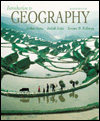 |  Introduction to Geography, 8/e Arthur Getis,
San Diego State University
Judith Getis
Jerome D. Fellmann,
University of Illinois, Urbana-Champaign
The Geography of Natural Resources
Objectives:After reading and studying this chapter you should be able to:
1.
Differentiate renewable and non-renewable resources.
|
 |  |  | 2.
Locate the countries or regions of the world which are the primary producers and consumers of important
mineral resources, including fossil fuels.
|
 |  |  | 3.
Distinguish between resources and reserves.
|
 |  |  | 4.
Explain how the exhaustion date of resources can be calculated.
|
 |  |  | 5.
Explain the advantages and disadvantages of the exploitation of synthetic fuels, nuclear energy and renewable
natural resources.
|
 |  |  | 6.
Describe the various processes for producing nuclear energy and enumerate the advantages and disadvantages
of each.
|
 |  |  | 7.
Identify the processes involved in the development of synthetic fuels and enumerate the advantages and
disadvantages of their exploitation.
|
 |  |  | 8.
Identify those areas of the world with the greatest potential for producing energy from non-conventional sources, as biomass, hydropower, wind, solar radiation, tides and geothermal power.
|
 |  |  | 9.
Describe the world situation regarding food resources, cultivation and yields.
|
 |  |  | 10.
Identify the sources of fish supply and major areas of production.
|
 |  |  | 11.
Discuss the basic principles of resource management.
|
 |  |  | 12.
Understand the changes taking place in our forests, wetlands, and oceans with regard to these as natural resources.
|
|



 2002 McGraw-Hill Higher Education
2002 McGraw-Hill Higher Education